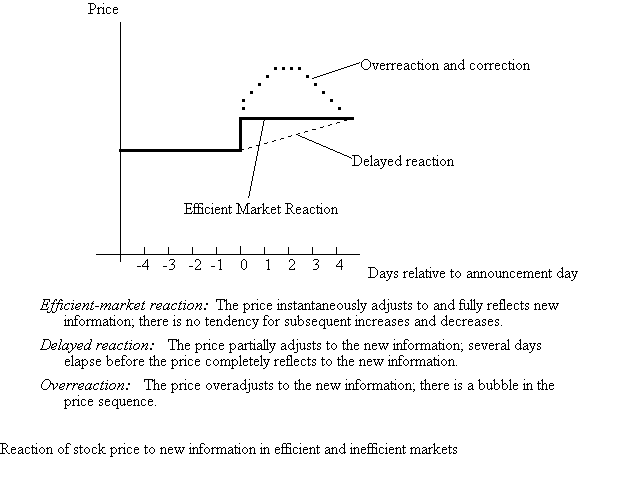Firms can create value from financing decisions in the following ways:
Financial Innovation is a difficult and high-risk strategy for value creation; which leaves us the first two strategies.
Empirical evidence suggests that the capital markets are informationally efficient, which rules out alternative one, leaving only alternative two as a potential source of value.
An efficient market is a market in which securities are priced according to their value given all publicly available information.
Consequently, a manager cannot usually hope to manipulate the market value of a firm. However, the fact that all relevant information is not available publicly means that the manager may be able to use his private information to choose financing strategies that do indeed dispossess the outside investor (e.g. selling overvalued stock). However, this generates agency costs, and hence does not work as a long term strategy.
With the above qualification, capital market efficiency implies:
Apparent evidence of market inefficiency may only indicate that new information is being revealed.
Example 1: Consider the LIFO vs FIFO decision. Several studies found that the market price of the stock rose on the switch to LIFO, and that the stock price increase was correlated with the size of the tax benefits. Why should there have been any effect at all? Did the market not know the tax effect of the switch before the announcement? Why was the switch not anticipated?
Example 2: In another study, Fama, Fisher, Jensen and Roll investigated the market reaction to 940 stock splits. They found that the market price rose for stock splits overall. But stock splits have no effect on cash flows! Is this a market inefficiency?
In inflationary times, the LIFO method allows the most expensive inventory to be used as the source of goods sold. This reduces taxable earnings; hence LIFO is preferable in such times.On the other hand, FIFO improves reported profits in times of inflation.
The eagerness with which a firm converts to FIFO could tell us the rate of turnover of its inventory, and its age. Unwillingness to convert could signal an undue preoccupation with reported income, perhaps because executive compensation is based on reported income.
FFJR found in their sample that stock splits that induced stock price rises tended to be followed by dividend increases. In other words, the stock split was an indicator of a dividend increase, which would indeed be new information.
(Question for the reader: Why should there be any correlation between stock splits and dividend increases?)

There seems to be some evidence that investors 'overreact.'
(Question for the reader: Is it possible for the 'overreaction' (and perhaps even the 'delayed reaction') sequence to be efficient? )
A project can be reliably identified as being positive NPV only if we can also identify the sources of that positive NPV. In general, the sources of such value enhancement represent some deviation from perfect competition in the product market, such as the existence of barriers to entry in the firm's industry, due to: